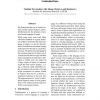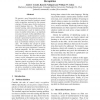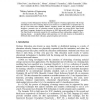223 search results - page 22 / 45 » Domain Adaptation of Maximum Entropy Language Models |
COLING
2010
13 years 2 months ago
2010
We demonstrate the use of context features, namely, names of places, and unlabelled data for the detection of personal name language of origin. While some early work used either r...
IJCNN
2007
IEEE
14 years 2 months ago
2007
IEEE
— Serious efforts to develop computerized systems for natural language understanding and machine translation have taken place for more than half a century. Some successful system...
MODELS
2009
Springer
14 years 2 months ago
2009
Springer
The proliferation of smart spaces and emergence of new standards, such as Web Services, have paved the way for a new breed of software systems. Often the complete functional and Qo...
ACL
2008
13 years 9 months ago
2008
We present a novel hierarchical prior structure for supervised transfer learning in named entity recognition, motivated by the common structure of feature spaces for this task acr...
PGLDB
2003
13 years 9 months ago
2003
Learning Content Management Systems (LCMS) supports e-learning applications with storage and efficient access for e-learning objects (LO)s. ROSA is a LCMS built as a semantic laye...



